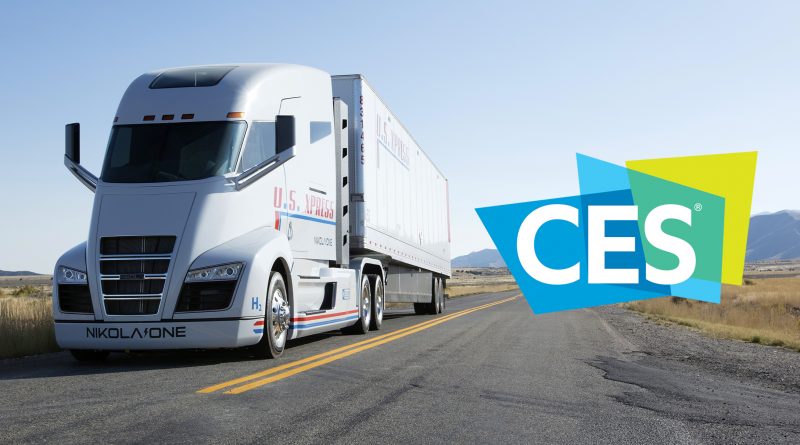CES 2020 review – shaping the future of road transport
The Consumer Electronics Show (CES 2020) in Las Vegas is a glimpse into the potential future – some not too far away and some a long time away – but either way they are a vision of a potential commercial vehicle future.
Nikola – Ryder alliance
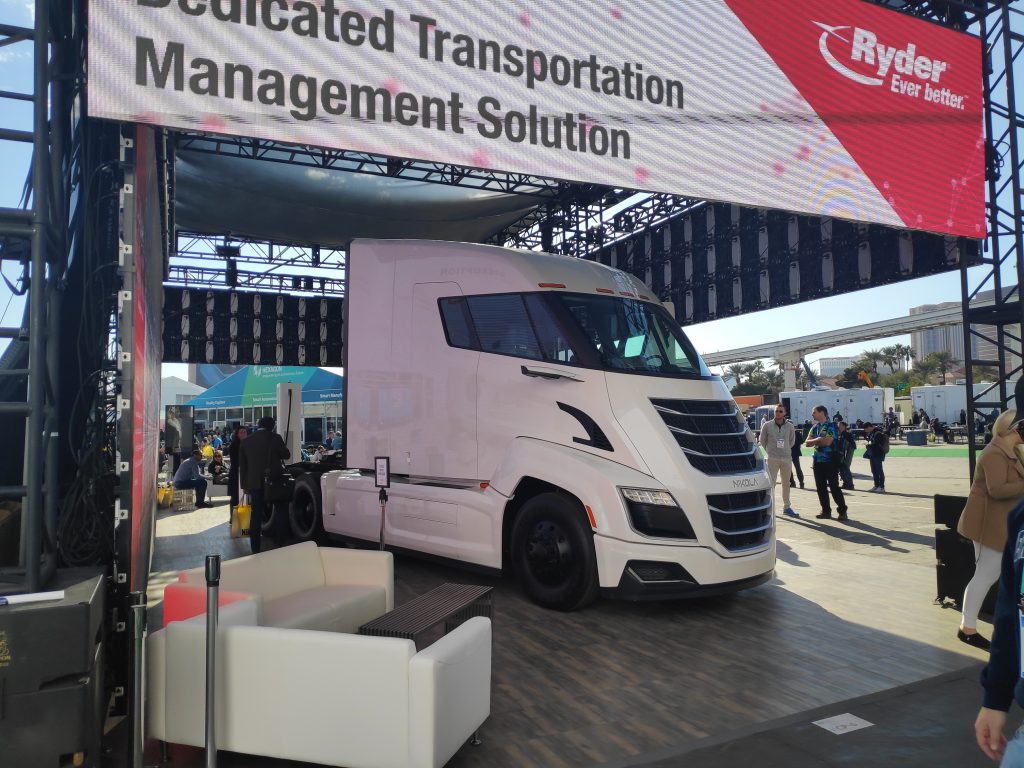
Neither Nikola nor Ryder should need any introduction to truck operators in the US and the UK, the fact they are working together is a great example of how a traditional supplier and new disruptor can co-operate for increased success and also cutting down the route to market time. Nikola already offer a customer ‘package’ based around a 700k mileage or 84-month agreement whichever comes first. The Ryder tie up allows a leasing and maintenance package to run alongside of this and also across the Ryder 800 branch / depot network in the US.
I have a full article on this subject area at Nikola – Ryder Trucks partnership.
Paccar
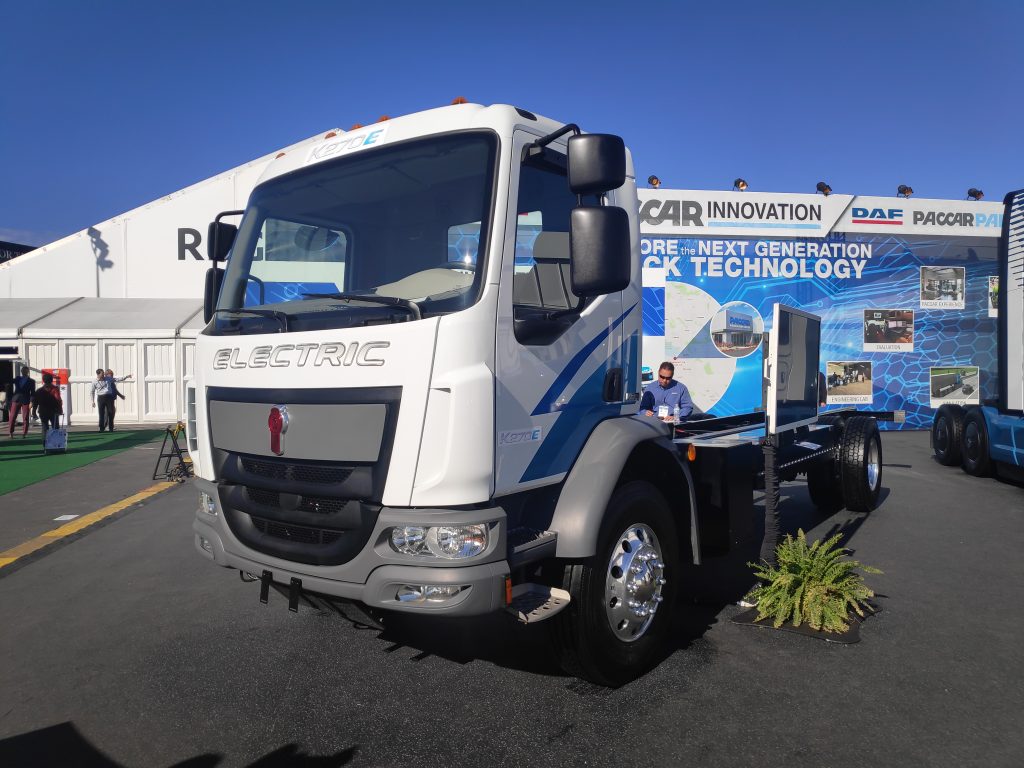
The Paccar group have been at CES for a couple of years now and show both Peterbilt and Kenworth product. Last year their focus was on Battery Electric Vehicles (BEV) and also the joint work they are undertaking with probably greatest automotive global exponent of Fuel Cell (FC) technology Toyota (for this moment I am not counting Nikola as a global brand ). Infact Paccar already have product working in California with this technology on a full scale trail.
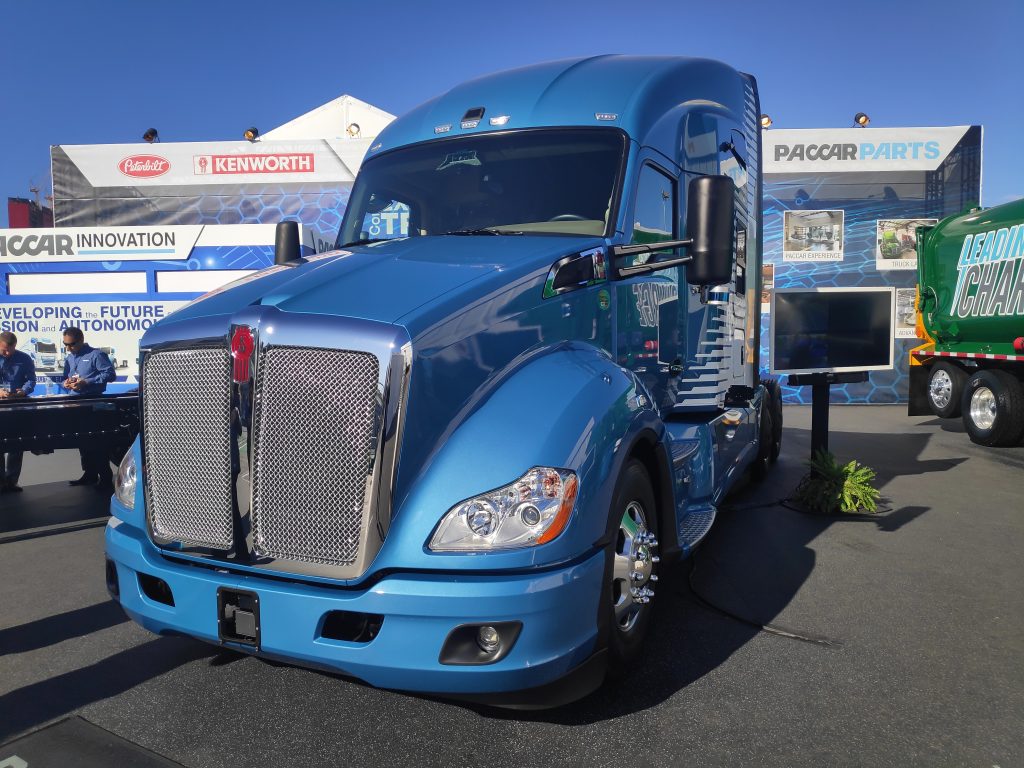
This year they had two Kenworths and a Peterbilt, a Class 6 / 7 Kenworth E270 which will look very familiar to UK operators as it boasts the DAF cab, referred to as “Cab-Overs” in the US, and uses technology similar to that used by the Leyland Trucks team and seen in Europe. It has the TM4 electric motive package from Dana Spicer featuring a modular set of batteries and motor as well as a battery management system (BMS). It has a 200 mile range with AC charging at 9 hours and DC charging at 1 hour dependent on the battery size which goes from 160, 200 and 240kWh.
The other Kenworth was a T680 sleeper cab tractor unit demonstrating Paccars autonomous vehicle technologies consisting of a mixture of cameras, Lidar and Radar products enabling Level 4 autonomy. There are nine cameras, backed up by a further three radar and three lidar systems.
Finally, there was an electric Peterbilt 520E 8×4 refuse (or ‘garbage’ for our American readers) truck with a tag axle but unlike the Kenworth using the Dana Spicer TM4 electric package it had a Meritor system with battery packs from Nissan. It was interesting as the refuse truck was a side bin loader so it had one of the two sets of batteries ( 308-420kWh capacity) at the rear of the cab and another set along one side of the chassis. The motor generates power of between 370-500 kW giving it a range of between 60-90 miles with a DC rapid charge time of 1 hour via the biggest charger connection I have ever seen on a truck, but it would have to be to give a one hour charge time for a 308-420kWh battery!
e.Go Mover
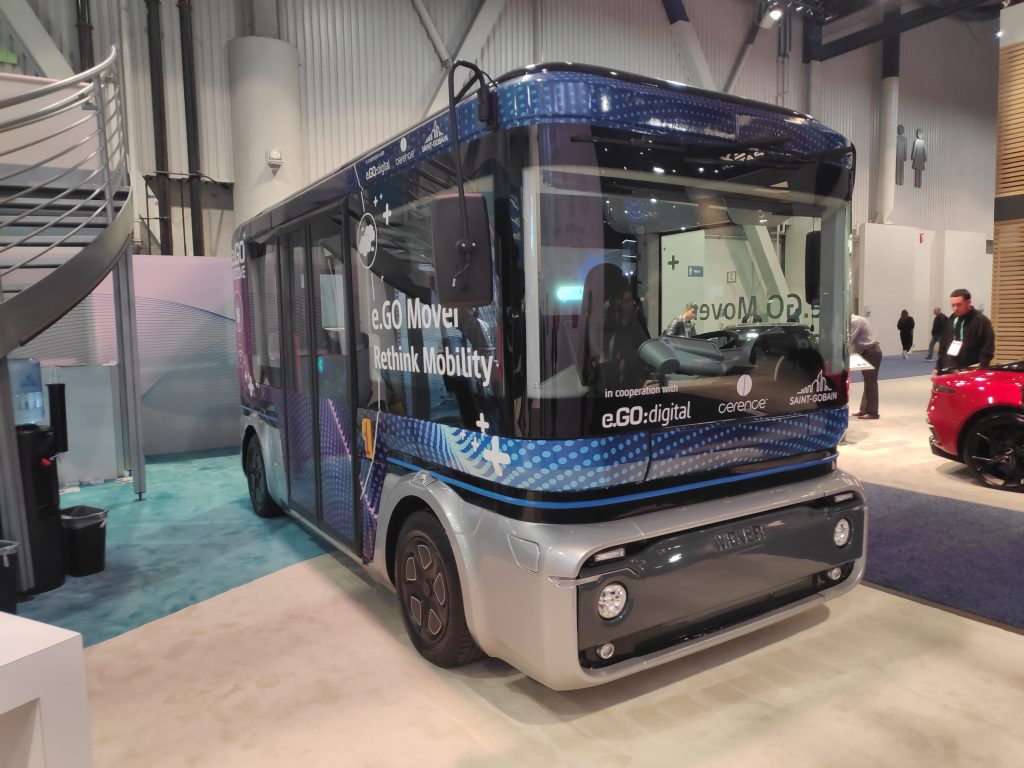
The e.Go has been developed by German company e.Go Moove along with Zukunft Ventures which is a subsidiary of the global Tier One supplier ZF so it has a lot of potential financial and development resources at its disposable. This vehicle was at the CES show last year were it made quite a stir and this continued for this year. Primarily seen as a people mover I am reliably informed there will also be a ”Cargo version” under development later this year with maybe a prototype available sometime during 2021.
The electric power motor is provided by ZF along with the chassis and automated driveline, which is no surprise as this is ZF’s area of expertise. The basic shell is lends itself to a number of applications from an airport shuttle to parcel delivery as well as supermarket delivery in fact any mission where urban delivery is the goal.
It has a low floor and very compact size measuring 4.9m in length and a height of 2.55m all on a 3.1m wheelbase offering a maximum cubic capacity of around 22 -24 cu m. Turning our attention to the weights side of the e.Go, it’s no surprise as a European designed product it has a maximum gross vehicle weight (GVW) of 3500kgs (7700lbs) and a payload potential of 1400kgs ( 3080lbs) obviously making the kerb weight 2100kg ( 4620lbs), making the e.Go figures uncannily similar to a traditional diesel powered large European van but having the ability to encompass the batteries and electric motor.
Which brings us on very nicely to the battery and motor specifications, the Lithium Ion battery can be specified upto 60kWh and the ZF motor reaches a maximum of 150kW, as a M2 European homolgated vehicle it is restricted to 60km/h but potentially this can be increased.
Of course no forward looking vehicle can be without some form of autonomy and cloud connection, and the e.Go is both available with Level 4 autonomy using cameras, radar and lidar systems.
Nissan USA
The Nissan stand was mainly based around the passenger car side of the business and there were no representatives from the commercial vehicle division although they did have a NV200 van on the stand. In fact to be exact it was the electric version the e-NV200 and it was used to offer CES delegates ice – creams from the rear and to show off its ability to dish out frozen products.
The irony of its inclusion on the stand only becomes apparent when you realise the e-NV200 is not available in the US, whilst two trim level versions of the NV200 are available, Nissan has not brought over the electric version.
There are probably a couple of reasons for this as no-one was available on the stand to talk to, one can only surmise that Nissan globally are selling as many electric NV200 as they can or at least they are happy to sell. This is probably confirmed by the fact the NV 200 factory in Barcelona is now only producing electric versions of the vehicle.
The second reason is they are already developing the replacement to the NV200 along with Renault ( this has been announced in Europe) so it just wasn’t worth the development and homologation costs to bring it over from Japan / Europe for a very limited time.
Nissan have a very extensive range in the US and the bulk of the commercial vehicle offerings are dedicated to the North American ( certainly not Europe) comprising of products such as the full size Titan Pickup and a range of “NV” vans and people carriers similar in size to the Transit Connect and Transit called the NV1500, NV2500 and NV3500. They also offer the Nissan Navara under the name of Frontier which completes their commercial vehicle offerings.
Ford
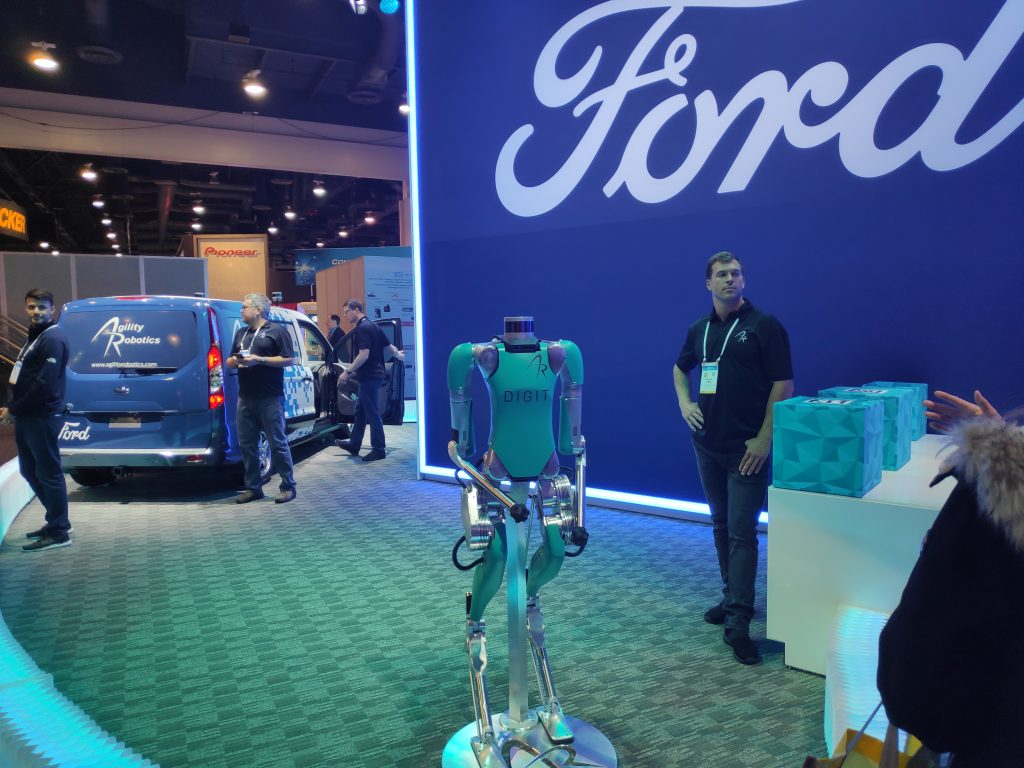
At CES 2020 the majority of the Ford stand was dedicated to the key areas of connectivity, autonomy and electrification with most of the products based around a large passenger car presence but the Ford commercial vehicle team did have a very interesting offering towards the back of the stand.
Last year they had a Transit Connect autonomous van on display and this year Ford Commercial vehicle have obviously been thinking at the parcel delivery market and have come up with a novel solution to help this industry. We have all been reading about the “final mile” or “last mile” delivery and the issues around this subject area, well Ford have taken a little further down the line and they are thinking about the final 100 metres or yards.
At the show Ford had a Transit Connect van, nothing special about that, but behind it was a two legged robot looking to deliver parcels out of the back of the van. Agility Robotics are a US based robotics company (Oregon state to be exact) and they are delivering a walking robot rather than a wheeled version – the reason ? According to the guys at Agility Robotics on the stand, 98% of households in the US have not got suitable access for wheeled robots, and in a future world of intense parcel deliver as well as supermarket delivery a robot that can walk upstairs has a big advantage.
The Agility Robotics team have developed two working protypes which Ford has taken delivery of and they will be working on integrating the robotic software with the vehicle software and how they can “talk” with each other to perform the duties of autonomous parcel delivery to customers requiring a robot that can walk upstairs.
Whilst at first glance this sounds a little farfetched, the intense delivery schedules even at today’s levels means as much automation is required to satisfy the demands envisaged in the foreseeable future.
AISIN
The company Aisin may not be very familiar to many people but they are one of the largest ( sixth to be exact) Tier One suppliers to the automotive industry and therefore have a good handle on where the industry is going and to showcase this Aisin have developed a next generation people and cargo mover. They turnover $35 billion and the group has over 200 consolidated companies and employs approximately 120,000 people worldwide.
The zero emission “i-mobility TYPE-C20”, which is a bit of a mouthful is very similar to a host of concept electric vehicle with Level 4 autonomy such as the e.Go and the Toyota e-Palette. On this vehicle Aisin are concentrating on the typical three common core areas of Autonomy, Connectivity and Electrification.
The TYPE-C20 uses various Aisin products designed for EVs, such as AISIN’s eAxle which is specifically designed for electric motive power; regenerative brake system; electric ramp and lower, rail-free power sliding doors; and heat management and optimal thermal control. These products all allow more space for a larger battery providing extended range although the company are a little vague on the battery / motor specifications.
Perhaps one of the more interesting additions to the concept vehicle was the integration of an electric “scooter” called “ILY-Ai “ into the design, which according to Aisin, is the world’s first multi-functional, electric intelligent personal mobility vehicle, it basically looks like a scooter.
The product is capable of human image recognition and has built-in intelligent safety systems based on robotics technology preventing it from colliding with people or things. Using vehicle navigation technology, it can optimise the route, if we combine all these functions into one system one can easily see this product could soon become a courier or parcel delivery system with a little “fine-tuning” and not much else.
Toyota
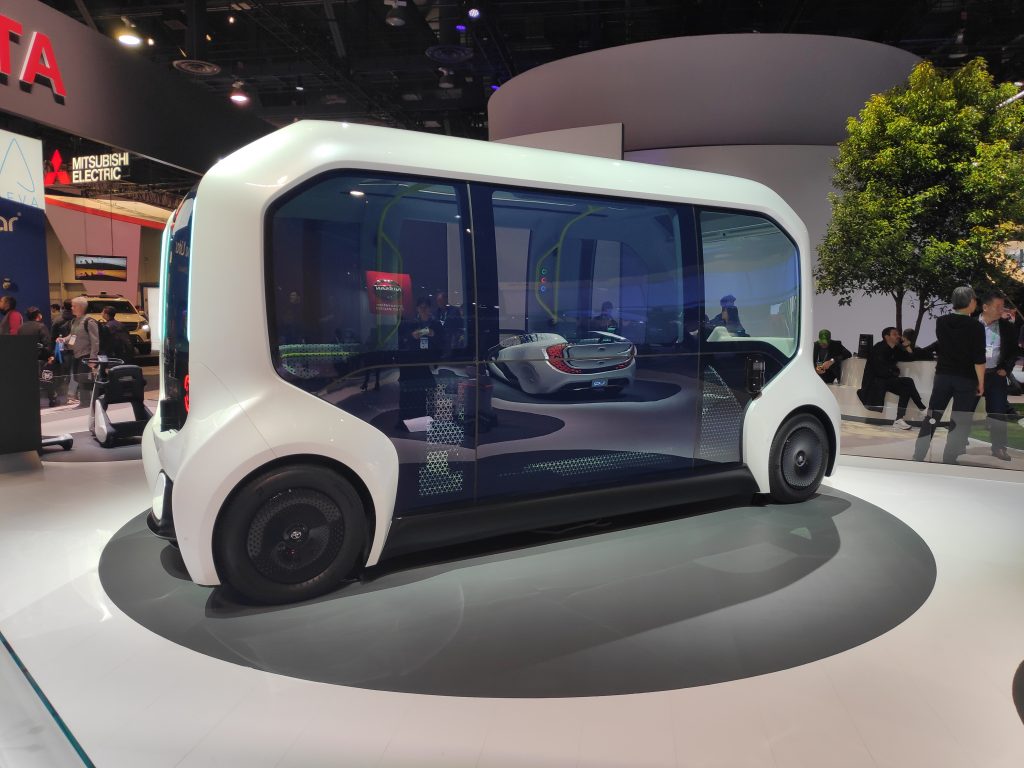
Toyota announced they are moving from being a transportation company into a mobility company and plan to build 175 acre “Woven City” at the base of Mount Fuji, and their stand was basically a mini example of what it could potentially look like.
As far as commercial vehicle product were concerned Toyota had their e-Palette battery electric concept vehicle which I think was first shown in 2018 at CES and was specifically designed for Mobility as a Service (MaaS) applications. The vehicle looks like every other concept people carrier or cargo van you see nowadays, there certainly isn’t much in the way of originality but that’s not a comment on Toyotas vehicle as it was one of the first and it appears everyone else has followed. Maybe it’s a case of imitation is the sincerest form of flattery. Of course, the vehicle features all of the other the prerequisite along with electric batteries such as automated driving capability, a low-floor and open concept interior, providing endless configuration options.
Also following the trend Toyota have an Autonomous delivery robot that utilizes omni-directional wheels for maximum manoeuvrability called micro-palette and its intended to be a multi-use device for product and package handling. Whereas the Ford final “100 metre” team are looking at a bi-ped robot solution via Agility Robotics Toyota are sticking to the more conventional wheeled variety, allowing for truck to doorstep delivery such as parcels and supermarkets, warehouse inventory movement, building-to-building transport of goods and neighbourhood delivery of products.
Plus.AI
Question: What have a group of Stanford graduates got to do with autonomous trucks? The answer: Plus.AI ! The company was founded by a group of friends at the prestigious Ivy League Universities less than five years ago and they continue to plough a very deep furrow in the highly competitive world of autonomous trucks.
The company was at last year’s CES with one vehicle, this year they were back at CES with two tractor units, one was an International Sleeper cab and the other was a very interesting day cabbed Peterbilt which I believe is the first day cab to have level 4 autonomy fitted to it.
They all also demonstrated a fully integrated system on the day cab and then a research and development system which had most of the cameras, radar and lidar equipment mounted on a “shelf” above the cab windscreen (windshield).
Despite the relatively small size compared to many of the large global players in the sector they have a breadth of “on the road” experience in the US and China where they have a working relationship with major truck manufacturer First Auto Works (FAW).
The company are concentrating on autonomous driving in every state in the US to try and gather data on all types of driving conditions from high sunshine states such as Florida to snow conditions in states such as Minnesota. They recently completed one of the longest journeys in level 4 going virtually from one coast of the states to the other, a 2800-mile route ending up in Pennsylvania.
According to Shawn Kerrigan one of the co-founders “We want to build a technology solution that is applicable across different weather, terrains, and driving scenarios. Testing our trucks’ readiness means we need to put them through stringent safety tests, on every highway in the country”.
Tim Campbell is the Managing Director of Campbells Consultancy, a globally-renowned consultancy company dedicated to the electrification of the commercial vehicle industry and publishers of Electric Van & Truck.
You may contact Tim by telephone (+44 1772 286225) or email (tim@campbellsconsultancy.com) or, alternatively, visit his company’s website (www.campbellsconsultancy.com).

